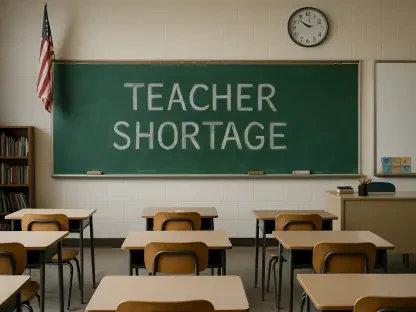New York City stands at a pivotal crossroads as the Trump administration delivers a harsh ultimatum: revise the policies safeguarding transgender students or face the loss of millions in federal funding for magnet schools. This escalating conflict, rooted in a clash between federal civil rights interpretations and local education guidelines, has thrust the nation’s largest school system into a high-stakes battle. With a tight deadline looming and substantial financial resources on the line, the situation poses critical questions about the future of transgender student protections. The tension not only highlights a profound divide between federal directives and city values but also underscores the broader national debate over transgender rights in educational settings. As city officials grapple with this pressure, the outcome could set a precedent for how local policies withstand federal challenges, making this a defining moment for both NYC and the country at large. The complexities of this issue demand a closer look at the various dimensions at play.
Federal Demands and Financial Risks
The Trump administration, through the U.S. Department of Education, has issued a clear demand for NYC to amend its policies that allow transgender students to engage in sports and use facilities consistent with their gender identity. Failure to comply by the stringent deadline risks the immediate loss of $15 million in federal funding for magnet schools in the next fiscal year, with a staggering total of $36 million potentially at stake over the remaining grant period. This financial threat is framed by the administration as a necessary response to what they claim is a violation of Title IX, the federal law prohibiting sex discrimination in education programs that receive federal support. This move is not isolated to NYC but mirrors a wider campaign to dismantle transgender protections in states like Virginia and Colorado, signaling a concerted effort to reshape educational policies nationwide. The implications of this ultimatum extend far beyond funding, touching on the core principles of equity and access in public education.
Beyond the immediate financial jeopardy, the federal stance raises profound questions about the autonomy of local school systems to craft policies that reflect their communities’ values. The magnet school funding at risk supports programs that serve diverse student populations, often providing specialized education that can be transformative for underserved groups. Losing such resources could disproportionately impact vulnerable students, adding a layer of ethical concern to the policy dispute. The Department of Education’s insistence on compliance by a rapidly approaching deadline further intensifies the pressure on NYC officials, leaving little room for deliberation or negotiation. This aggressive timeline suggests a deliberate strategy to force swift capitulation rather than foster dialogue, positioning NYC in a precarious spot where financial stability and policy integrity are pitted against each other. The broader national context of similar threats to other states only amplifies the urgency for a resolution that balances federal demands with local priorities.
Clash Over Civil Rights Interpretations
At the heart of this conflict lies a fundamental disagreement over the interpretation of Title IX and its application to transgender student rights. Federal officials have expressed significant concern over NYC’s policies, asserting that allowing transgender students to access bathrooms and participate in sports aligned with their gender identity contravenes federal civil rights law. This perspective, driven by the Department of Education’s Office for Civil Rights, marks a sharp divergence from earlier federal guidance that supported inclusive policies, as well as from local and state laws in New York that explicitly protect such rights. The contention over Title IX’s scope has become a flashpoint, with NYC’s commitment to fostering an inclusive environment now directly challenged by a federal reinterpretation that prioritizes a narrower definition of sex discrimination. This dispute encapsulates a larger ideological struggle over the role of federal authority in shaping educational equity.
The ramifications of this interpretive clash extend into the daily lives of transgender students, whose access to safe and affirming spaces hangs in the balance. NYC’s policies have been designed to ensure that these students can navigate school environments without fear of exclusion or discrimination, reflecting a broader ethos of acceptance that contrasts starkly with the federal stance. Critics of the administration’s position argue that rolling back these protections not only undermines student well-being but also disregards established legal precedents at the state level that affirm transgender rights. The ongoing debate over Title IX in this context reveals a deep-seated divide between those advocating for restrictive federal oversight and those championing local autonomy in addressing the needs of marginalized groups. As this legal and ethical battle unfolds, the resolution could redefine how civil rights laws are applied to transgender individuals in educational settings across the country.
Internal Tensions Within NYC Leadership
Within NYC, the response to the federal ultimatum has exposed a rare public divide among top officials, complicating the city’s approach to this crisis. Mayor Eric Adams has voiced personal discomfort with certain aspects of the current transgender student policies, particularly scenarios involving shared facilities, suggesting a potential willingness to consider federal demands. This stance has sparked concern among advocates who fear a retreat from the city’s inclusive framework. In contrast, Schools Chancellor Melissa Aviles-Ramos has firmly upheld the existing guidelines, emphasizing their alignment with NYC’s values of diversity and equity. Although spokespersons for both leaders downplay any significant conflict, asserting a shared commitment to student welfare, the differing public statements reflect underlying challenges in presenting a unified front. This internal friction adds a layer of uncertainty to how the city will ultimately navigate the federal pressure.
The implications of this leadership rift extend to the broader policy-making process, where competing perspectives could hinder swift and decisive action. Adams’ comments, lacking specific incidents to substantiate his concerns, have drawn criticism from state education officials and civil rights groups who argue that current policies are both legally sound and essential for transgender students’ safety. Meanwhile, Aviles-Ramos’ steadfast defense positions her as a key advocate for maintaining the status quo, potentially placing her at odds with the mayor’s exploratory stance. This dynamic underscores the difficulty of balancing personal viewpoints with institutional responsibilities under intense external scrutiny. As the deadline for compliance approaches, the lack of cohesion among NYC’s leadership could influence the city’s ability to mount a robust response, leaving stakeholders anxious about the direction of future policy decisions and their impact on student protections.
Legal Challenges and Procedural Hurdles
In a bid to counter the federal ultimatum, NYC’s Education Department, under the guidance of top lawyer Liz Vladeck, has initiated a procedural pushback, questioning the legitimacy of the funding threat. A formal request for a 30-day period to consider an appeal was submitted, challenging the connection between Title IX interpretations and the specific magnet school grants at risk. The argument hinges on a perceived lack of due process, as federal regulations typically mandate a more thorough review before such punitive measures are enacted. However, federal officials swiftly rejected this plea, enforcing a deadline tied to the fiscal year’s close on September 30, which severely restricts the city’s window for legal maneuvering. This rigid stance by the Department of Education amplifies the urgency, placing NYC in a position where immediate compliance certification seems almost unavoidable, despite lingering questions about the decision’s fairness.
The legal challenge also sheds light on the broader implications of federal overreach into local education funding. By tying compliance to an unrelated grant program, the administration’s approach raises concerns about the arbitrary use of financial leverage to enforce policy changes. NYC’s legal team contends that this disconnect undermines the integrity of federal oversight, potentially setting a dangerous precedent for how funding disputes are resolved in the future. The rejection of the appeal timeline further exacerbates the situation, leaving the city with limited options to contest the decision through established channels. This procedural deadlock not only heightens the stakes for magnet school programs but also tests the resilience of local governance in the face of federal mandates. As the fiscal deadline looms, the outcome of this legal skirmish could shape the boundaries of federal influence over state and city-level education policies for years to come.
Political Dimensions and Speculation
Adding a layer of intrigue to the policy dispute, speculation has emerged regarding potential political motivations influencing Mayor Adams’ public stance on transgender student policies. Reports have circulated that the Trump administration might be considering offering Adams a position or other incentives, possibly to sway his perspective or encourage his exit from the mayoral race for broader political gain. While both Adams and his spokesperson have categorically denied any influence from funding threats or job offers, these unconfirmed rumors inject a dose of uncertainty into an already complex situation. The possibility of behind-the-scenes maneuvering suggests that the debate over transgender protections might be intertwined with larger political strategies, extending beyond the immediate concerns of education funding and student rights. This undercurrent of speculation keeps the focus partially shifted from policy to personal ambition.
Despite the lack of concrete evidence supporting these political rumors, their mere existence underscores the charged atmosphere surrounding this issue. The intersection of local governance with national political agendas raises questions about the integrity of decision-making processes when high-profile figures are involved. For many observers, the focus remains on how these potential influences could subtly shape NYC’s response to the federal ultimatum, especially if financial or career considerations are at play. Meanwhile, the core issue of transgender student protections risks being overshadowed by this narrative of political gamesmanship, diverting attention from the urgent needs of students and the educational programs at stake. As the situation develops, clarity on whether policy decisions are driven by principle or pragmatism will be crucial in assessing the true motivations behind NYC’s ultimate course of action in this contentious standoff.
Navigating the Path Forward
Reflecting on the intense standoff that unfolded, the Trump administration’s demand for NYC to revise transgender student policies under the threat of losing critical magnet school funding marked a significant clash of federal and local priorities. The internal discord between Mayor Adams and Chancellor Aviles-Ramos, coupled with procedural challenges and whispers of political maneuvering, painted a picture of a city caught in a multifaceted struggle. Looking ahead, the resolution of this conflict demanded a strategic approach that prioritized student well-being while safeguarding educational resources. NYC officials needed to explore legal avenues for appealing federal decisions, potentially collaborating with state authorities to reinforce local policies. Engaging civil rights advocates to amplify the importance of transgender protections offered a path to build broader support. Ultimately, crafting a unified stance that balanced compliance pressures with core values emerged as a vital step to ensure that future challenges did not compromise the city’s commitment to inclusivity.









